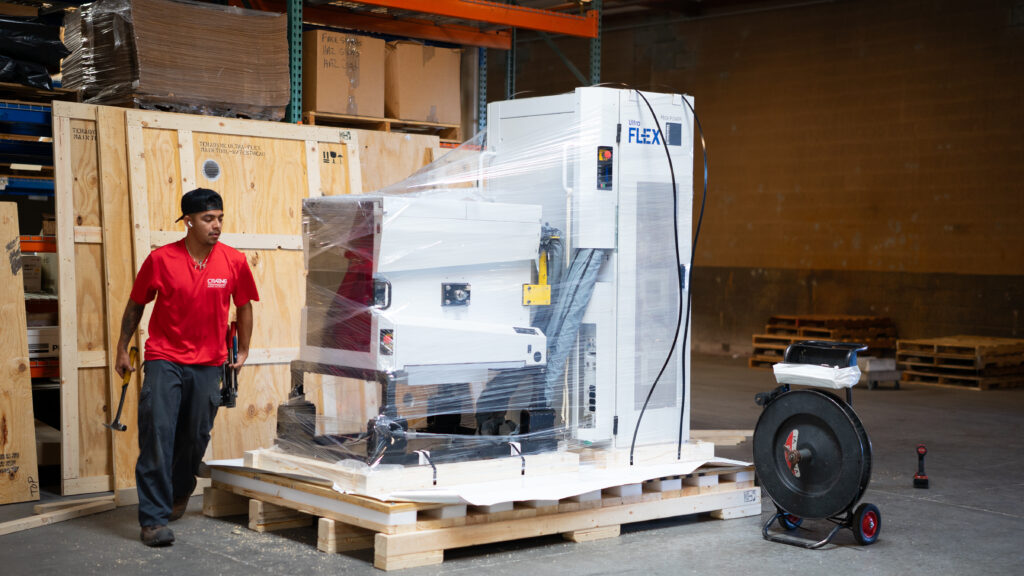
Can you build a custom crate for equipment you haven’t physically seen yet?
Designing crates without seeing equipment might sound improbable, but it’s a challenge we embrace regularly. We hear this question more often than you’d expect—and we confidently answer yes. In fact, many of our most intricate and successful projects begin without ever handling the actual product. Creating secure, regulation-compliant packaging without physical access? That’s exactly where we thrive.
Industries like defense, aerospace, medical devices, semiconductors, and advanced manufacturing frequently deal with products still in development or mid-QA. Despite this, packaging still needs to move forward. Consequently, the challenge becomes clear: finding a partner who delivers smart, secure solutions without relying on a final, physical product.
At Crating Technology, we’ve honed a detailed, digital-first approach to custom crate design, so that we don’t require product access ahead of time. Our method relies on close collaboration, engineering precision, and a deep understanding of evolving technical needs.
Let’s walk through our process.
Custom Crate Design Without Product Access
Even if the equipment hasn’t arrived, your team probably already holds valuable reference materials. These resources form the cornerstone of our design process. Regularly, we work from:
- CAD files and 3D models
- Technical schematics or dimensional drawings
- Assembly photos or walkthrough videos
- Handling and tolerance specifications
- Weight estimates and center of gravity data
- Environmental and regulatory guidelines
With these, we build a solid blueprint. While your engineers refine the prototype, we get a head start on crate design—keeping timelines lean and logistics streamlined. This method is crucial when designing crates without seeing equipment, allowing us to move confidently and quickly despite not handling the final product.
Ultimately, this parallel development approach protects your internal resources. You stay focused on innovation, not shipping logistics.

Collaborating with Your Engineers and Project Managers
Designing a custom crate involves more than just measurements. It requires close coordination. Because of this, we engage proactively with your engineering, logistics, and operations teams to ensure nothing falls through the cracks.
We’ll help identify:
• Which surfaces require full support (and which are off-limits)
• Mounting or lifting point locations
• Ideal crate orientation for secure transit
• Requirements for anti-static, vibration-dampening, or moisture-resistant materials
After all, a crate should enhance—not complicate—your innovation, especially when designing crates without seeing equipment is necessary from day one.
Modeling a Crate for Equipment We Haven’t Seen
Yes, designing for an unseen product presents challenges. Yet we tackle them with confidence and proven tools. Through advanced 3D modeling and digital simulations, we ensure every detail fits. This expertise is especially critical when designing crates without seeing equipment, since every decision must rely on data, not direct interaction.
Our detailed crate models include:
• Custom foam layouts and support systems
• Precise bracing and load-bearing features
• Handling access points and lift guides
At Crating Technology, we design with compliance in mind, so that we’re always meeting MIL-SPEC, ISPM 15, and any specific transport standards. Every element reflects the product’s shape, function, and fragility.
Before production begins, we share our digital designs with your team for approval. If needed, we send prototype elements—such as a foam insert—for hands-on validation with your mock-up or dev unit.
This method leads to fewer surprises, quicker lead times, and complete confidence that everything fits—right from the first shipment.

Real-World Example: Crating a Prototype Medical Device
Recently, a client in the medical tech space needed crates for a diagnostic device still under development. Physical units hadn’t reached final assembly yet—but the shipment window had already opened.
Using CAD data and early-stage specs, so that we could develop a crate and a foam system tailored to the device. Working closely with the client’s engineers, we:
- Avoided critical access ports
- Accounted for internal cable routing
- Protected structural load-bearing elements
As a result, all three prototypes reached clinical partners without any hiccups—no damage, no downtime, and zero rework.
Trusting the Process When the Product Is Still Evolving
When your product evolves in real-time, your packaging partner must remain agile, precise, and collaborative. That’s exactly how we operate. With our digital design tools and proactive coordination, we solve packaging puzzles—before your equipment even hits the production line.
So, if you’re racing against a deadline—or shipping an unfinished product—rest easy. The absence of a physical unit won’t hold you back.
All you need is a partner who knows how to design with the unknown in mind.
Have a prototype or incomplete product you need to ship?
Let’s build the right packaging solution—no guesswork required.



